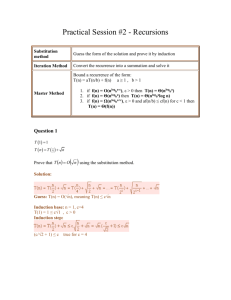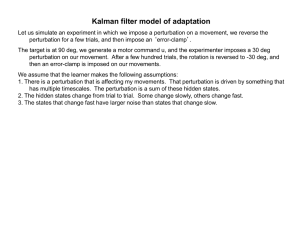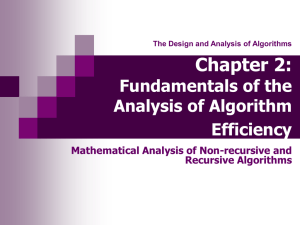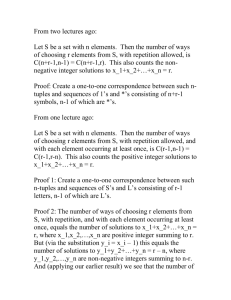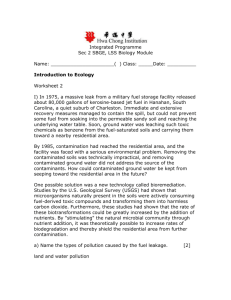Lecture 13
advertisement
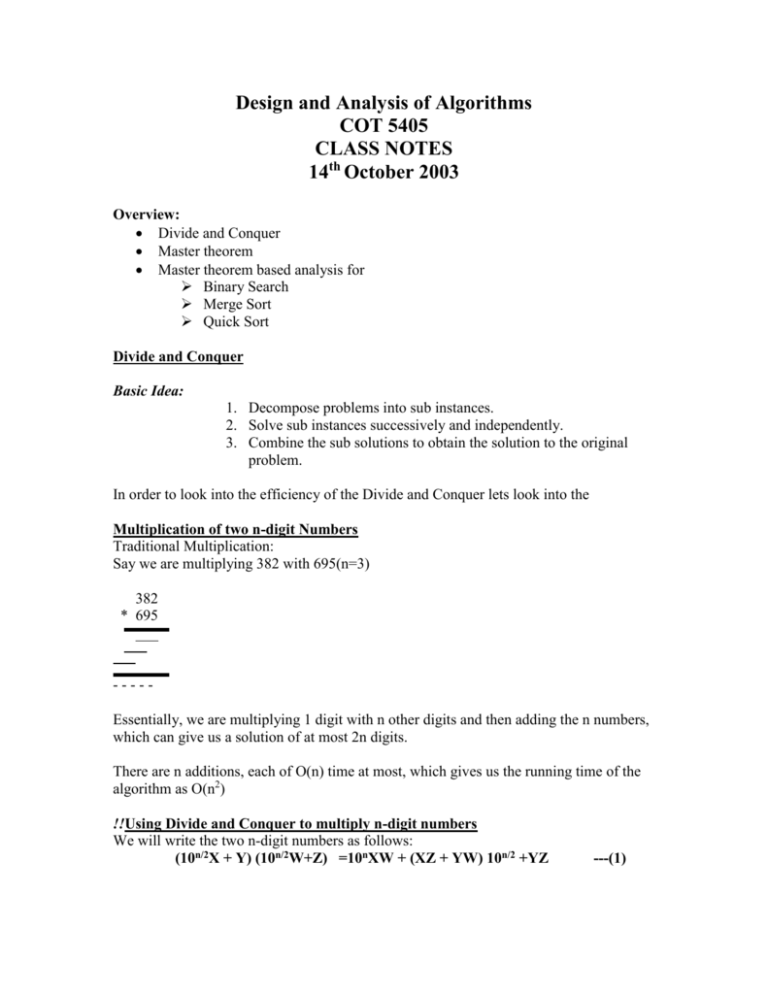
Design and Analysis of Algorithms
COT 5405
CLASS NOTES
14th October 2003
Overview:
Divide and Conquer
Master theorem
Master theorem based analysis for
Binary Search
Merge Sort
Quick Sort
Divide and Conquer
Basic Idea:
1. Decompose problems into sub instances.
2. Solve sub instances successively and independently.
3. Combine the sub solutions to obtain the solution to the original
problem.
In order to look into the efficiency of the Divide and Conquer lets look into the
Multiplication of two n-digit Numbers
Traditional Multiplication:
Say we are multiplying 382 with 695(n=3)
382
* 695
----Essentially, we are multiplying 1 digit with n other digits and then adding the n numbers,
which can give us a solution of at most 2n digits.
There are n additions, each of O(n) time at most, which gives us the running time of the
algorithm as O(n2)
!!Using Divide and Conquer to multiply n-digit numbers
We will write the two n-digit numbers as follows:
(10n/2X + Y) (10n/2W+Z) =10nXW + (XZ + YW) 10n/2 +YZ
---(1)
That is we are converting the multiplication of two n-digit numbers into multiplication of
four n/2 digit numbers, plus some extra work involved in additions. We are recursively
calling multiplication and performing some additions in every recursion.
Let T (n) be the running time of multiplying two n-digit numbers.
Then in our case,
T (n) = 4T (n/2) +O (n)
Four multiplications of n/2 digit numbers
Addition is going to be between numbers that have atmost 2n digits. Thus
addition can be O (n).
Recursively substituting the value of T (n):
T (n) = 4 [4T (n/4) + O (n/2)] +O (n)
=16 T (n/4) + 4O (n/2) + O (n)
=C T (1) + - - - Master’s Theorem
Let T(n) be the running time of an algorithm with an input size of n;
Suppose we can run the algorithm in such a way that we make ‘a’ recursive calls every
time with an input size of ‘n/b’ and do some extra work in every recursion (additions and
subtractions).
Such that T (n) can be represented as:
T (n) = a T (n/b) + O (nk),
Then,
If log ba>k, T (n) =O (nlog ba)
If log ba=k, T (n) =O (nklog n)
If log ba<k, T (n) =O (nk)
(recursive calls dominates)
(almost equal work in rec. calls and in extra work)
(Extra work dominates)
In our multiplication problem:
T (n) = 4T (n/2) +O (n)
A=4, b=2
Log24=2, k=1
Since algorithm is dominated by recursive calls and the running time is O (n2).
But this is as good as our traditional multiplication algorithm. Since we now know that
multiplications dominate the running time, if we can reduce the number of
multiplications to three, which can bring down our T(n) by 25%.
To calculate (1), we just need the following 3 multiplications separately:
1. (X+Y)(W+Z)
2 additions and one multiplication
2.XW
3.YZ
Then we can calculate
XZ+YW=(X+Y)(W+Z)-XW-YZ
Thus we use three multiplications at the expense of some extra additions and
subtractions, which run in constant time( each of O(n) time)
Thus,
T(n)=3T(n/2) + O(n)
Applying Master’s theorem,
A=3,b=2,k=1
Thus, T(n)=O(nlog23)
Since log 3 ~ 1.5,
2
We have reduced the total number of recursive calls in our program. For very large n, it will work well
but in actual implementation, we hardly code to gain advantage out if this feature.
Binary Search
Goal: Searching for nth value in a sorted list of length n.
(Divide the list into two and recursively search in the individual lists half the size)
Again,
Let T(n) be the running time of the algorithm. Then,
T(n)=T(n/2) + O(1)
In O(1) time we divide the list into two halves(n/2) that run in T(n/2) time.
Using Master’s theorem,
A=1,b=2
Log21=0
K=0;
So,
T(n)=O(log n)
Merge Sort
Goal: Splitting the element list into 2 lists, sort them and merge them.
T(n)=2T(n/2) + O(n)
Here, the hidden constant is greater than the hiddent constant in the merge sort because
while dividing the lists into two different arrays and then sorting them, we are allocating
extra space and subsequently, copying into the original array.
Using Master’s theorem,
A=2,b=2,k=1
Log22=1
So, T(n)=O(n log n)
Quicksort
Goal: Pick one element as the partition element. Put all the elements smaller than it, to
the left of it and all elements greater than it, to the right of it. On the lists left and right of
the partition element recursively call Qsort.
Say the list is: 8,3,6,9,2,4,7,5
Partition element:5
8, 3, 6, 9, 2, 4, 7, 5
Last
front
8 in the worng place, 7 fine.
8, 3, 6, 9, 2, 4, 7, 5
front
Last
4 ,3 ,6 ,9 , 2 ,8 ,7 ,5
front
last
4, ,3, 2, 9, 6, 8, 7, 5
front
last
4, 3 ,2 ,9 ,6 ,8 ,7 ,5
last
front
Now swap front with 5 and we have 5 in place.
4,3,2,5,6,8,7,9
Thus the only extra space utilized here is the temporary variable used for swapping.
In te worst case, we might end up choosing a partition element which is the first element
in our list.
In that case T(n)=O(n2)
To make sure this rarely happens:
1. Pick a random partition element.
2. Probablity of picking a good partition element is as low as the probability of
picking a bad one. So, they will even out.
There are n possible partition elements
Element
Split
Prob(element)
1
2
3
0,n-1
1,n-2
1/n
1/n
1/n
N
n-1,0
1/n
Now,
T (n) = 1/n [ T(0) + T(n-1) + O(n) ] +
1/n [ T(1) + T(n-2) + O(n) ] +
1/n [ T(2) + T(n-3) + O(n) ] +
……
……
……
1/n [T (n-1) + T (0) + O (n)]
n * T[n] = {2 k=0n-1T(k)} + O(n2) A
Substitute n = n-1,
(n-1) * T[(n-1)] = {2 k=0n-1T(k)} + O((n-1)2)B
Subtract A from B
n T(n) - (n-1)T(n-1) = 2 T(n-1) + O(n)
n T(n) = n+1 T(n-1) + O(n)
T(n) = ((n+1)/n )T(n-1) + O(1)
Divide by (n+1)
T(n)/(n+1) = [T(n-1) ]/ n + O(1/n) C
Let,
S(n) = T(n)/(n+1) D
S(n) = S(n-1) + O(1/n)
This can be written as a sum,
= S(n-2) + O(1/n-1) + O(1/n)
= S(n-3) + O(1/n-2) + O(1/n-1) + O(1/n)
S(n) = O(k=1 n 1/k)
= O( Hn)
S(n) = T(n)/(n+1) = O (ln n) E
Substitute D in C
T(n) = S(n) . (n+1)
use E,
T(n) = O (ln n) . (n+1)
T(n) = O (n lg n )
Notes compiled by Shankar Vaithianthan and Harjinder Mandarh

